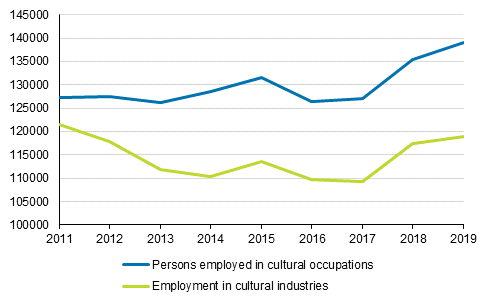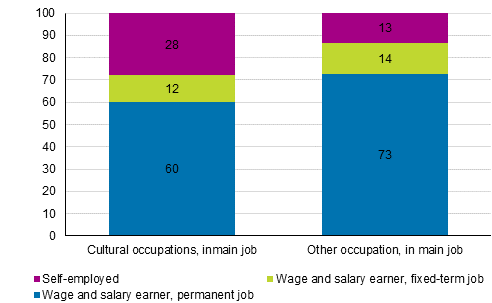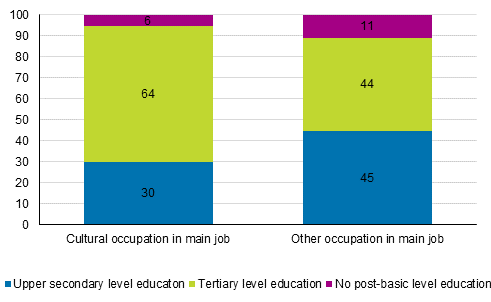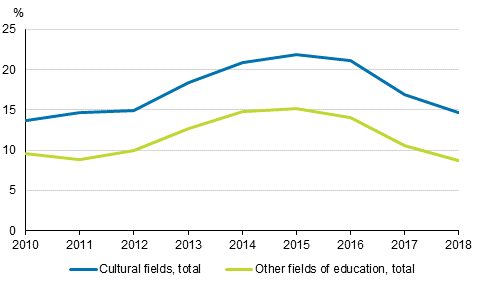Published: 10 June 2020
Number of persons working in cultural occupations and industries still increased in 2019
In 2019, the employment development was favourable in both the national economy and the fields of culture. According to Statistics Finland’s Labour Force Survey, employment in cultural industries was around 118,820 (95% confidence interval +- 3,300). The growth from the year before amounted to 1.6 per cent (Figure 1).
Figure 1. Employment in cultural industries and occupations as main job in 2011 to 2019

Source: Statistics Finland: Labour Force Survey
According to the definition of the Labour Force Survey, a person is employed if he/she has during the survey week been in gainful employment for at least one hour against pay in money or fringe benefits, or to make a profit. Employees temporarily absent from work during the survey week are also classified as employed if the reason for absence is maternity or paternity leave or own illness or the absence has lasted for under three months. A self-employed person or an unpaid worker in an enterprise of a family member is calculated in employed regardless of the length or reason for absence.
The main job is the only or main paid job of an employed person. If there are several jobs, the main job is usually the one on which most time is spent or from which earned income is highest. The definition of the main and secondary job is based on the respondent's own reporting.
A considerably large share of those working in cultural occupations were self-employed. Seventy-two per cent were working as wage and salary earners and 28 per cent were self-employed, while the shares in other occupations were 87 and 13 per cent (Figure 2).
Only 60 per cent of those employed in cultural occupations had a permanent employment relationship, while the corresponding share for those working in other occupations was 73 per cent. The difference is explained by the large share of self-employed persons. Twelve per cent of those employed in cultural occupations worked in fixed-term positions and the remaining 28 per cent were self-employed.
Figure 2. Permanency of employment relationship in cultural and other occupations as main job in 2019

Part-time work was considerably more common in cultural occupations than in other occupations. Twenty-four per cent of those in cultural occupations had a part-time job, while in other occupations only 17 per cent worked part time.
Persons working in cultural occupations often perform project-type short-term jobs, and several simultaneous jobs are also common. Around 10 per cent of those in cultural occupations had more than one job and about six per cent of those working in other occupations in 2019.
The average weekly working time of those working in cultural occupations as their main job is slightly shorter than among those in other occupations. It was 33 hours in cultural occupations and nearly 35 hours in other occupations.
In both cultural occupations and industries, the number of men and women on the total level was almost equal. In cultural industries, around 52 per cent were women in 2019 and in cultural occupations nearly 57 per cent.
Male-dominated occupations include sales and marketing managers (74 per cent of men in 2017), broadcasting and audio-visual technicians (72 per cent), printers (78 per cent), print-finishing and binding workers (64 per cent).
Female-dominated occupations include archivists (70 per cent) and librarians (81 per cent) and curators (77 per cent), interior designers (85 per cent), dancers and choreographers (71 per cent), and arts and crafts teachers (70 per cent) ( Employed labour force in cultural occupations by gender) .
Cultural professionals are highly educated. A total of 64 per cent of those working in cultural occupations had tertiary level education, while the share was only 44 per cent in other occupations. In all, 30 per cent of employed persons in cultural occupations and nearly 45 per cent of those in other occupations had upper secondary level education. Good five per cent of those employed in cultural occupations had not acquired post-basic level education (Figure 3).
These data derive from Statistics Finland’s Labour Force Survey and the employment statistics.
Figure 3. Level of education distribution of those working in cultural and other occupations as their main job in 2019, %

Unemployment rate of those with qualifications in the field of culture one year after graduation
Statistics Finland has revised the compilation of statistics on cultural education. The classification is based on the set selected from the national classification of education 2016 (https://stat.fi/en/luokitukset/koulutus/koulutus_1_20160101/). Previously, the Finnish National Board of Education's classification of fields of education was used in the cultural statistics tables (see for more details Cultural education ).
The unemployment rate of those with qualifications in the field of culture one year after graduation has long been higher than the average unemployment rate of all fields of education ( Cultural Statistics’ database table )
Figure 4. Unemployment rate of those with qualifications from the cultural industry and from all fields of education one year after graduation in 2010 to 2018 (%)

Source: Statistics Finland, Education statistics
In 2019, the number of unemployed jobseekers in arts occupations was on average 6,047, around 2.7 per cent lower than in the year before. Of all unemployed jobseekers 2.5 per cent were arts professionals. Visual artists made up 37 per cent of all unemployed jobseekers in arts occupations.
The average for unemployed jobseekers in arts in the first quarter of 2020 was 6,929, of whom 261 were laid off. Compared to 2019, unemployment increased most among visual artists, which grew by 228 unemployed or laid off persons. The number of unemployed among musicians grew by 165 and among stage artists by 121 ( Cultural Statistics’ table service, Table 11.7 ).
These data derive from Statistics Finland’s education statistics and the Employment Service Statistics of the Ministry of Economic Affairs and Employment.
Earnings in cultural occupational groups
According to the structure of earnings statistics, the number of full-time monthly wage and salary earners in the private sector was 733,540 in 2018. There were nearly 31,900 wage and salary earners in cultural occupations, over four per cent.
Advertising and public relations managers working in cultural occupations attained earnings of over EUR 6,600. The average earnings of men were good EUR 6,700 and of women EUR 6,500. The earnings were lowest, around EUR 2,436, among technical employees at galleries, museums and libraries ( Cultural Statistics’ table service, Table 11.9 ).
In 2019, around 357,760 persons worked in the local government sector, of whom 5,300 were working in cultural occupations. In the local government sector, the average regular monthly earnings were about EUR 3,180. In cultural occupations in the local government sector, they were EUR 2,840, on average. Theatre directors earned most, almost EUR 5,500, on average. City architects also attained earnings of nearly EUR 5,280. Museum assistants’ earnings remained under EUR 2,000 as they earned EUR 1,970, on average ( Cultural Statistics’ table service, Table 11.8) .
According to the preliminary estimate based on the national Incomes Register , taxable earned income paid to wage and salary earners decreased adjusted for working days by 4.3 per cent in April 2020 compared with the previous year. If the change in income is viewed without one-off pay items, the drop was 3.9 per cent.
Taxable earned income paid to wage and salary earners in the whole economy amounted to around EUR 7.1 billion in April 2020. In April 2019, the corresponding sum was EUR 320 million higher. For individual industries, the biggest drop occurred in accommodation and food service activities, where wage and salary income is estimated to have contracted by 34 per cent. Industry R: “Arts, entertainment and recreation” is also having a bumpy ride. The drop was around 17 per cent (Tieto&trendit blog: Palkkatulot pienenivät huhtikuussa 2020 – tulorekisteri tositoimissa , in Finnish).
Source: Cultural statistics 2019 Statistics Finland
Inquiries: Kaisa Weckström 029 551 2348, kulttuuri.tilastokeskus@stat.fi
Director in charge: Jari Tarkoma
Publication in pdf-format (236.3 kB)
- Tables
-
Tables in databases
Pick the data you need into tables, view the data as graphs, or download the data for your use.
Updated 10.6.2020
Official Statistics of Finland (OSF):
Culture [e-publication].
ISSN=2341-7404. Cultural Employment in Finland 2019. Helsinki: Statistics Finland [referred: 23.12.2025].
Access method: http://stat.fi/til/klt/2019/01/klt_2019_01_2020-06-10_tie_001_en.html

